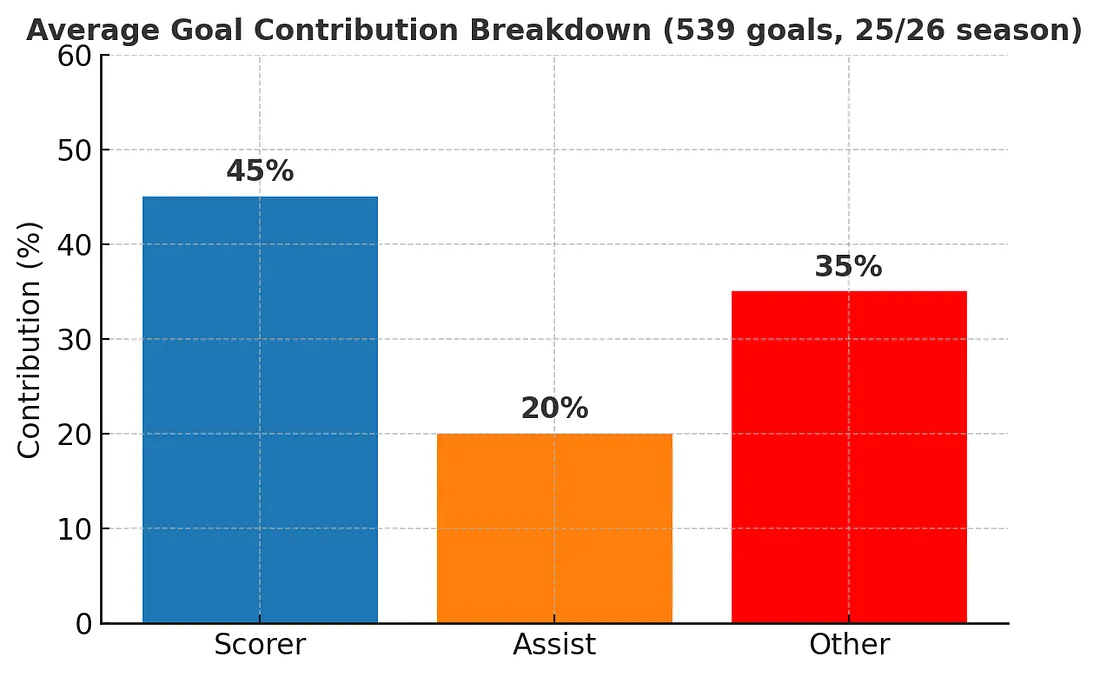
Global Insight: Who gets forgotten in goals? The 35% we don’t talk about
The Hidden 35%: Rethinking Goal Contributions in Football
When we talk about goal contributions in football, the conversation always stops at two names: the scorer and the assister.
One gets the goal, the other gets the assist. End of story.
But is that really the full story?
Breaking 500+ goals in detailled contributions
Over the first weeks of the 2025/26 season, we tracked 539 goals across the five major European leagues — the Premier League, La Liga, Ligue 1, Bundesliga, Serie A and the Champions League.
For each goal, we didn’t just record the scorer and assister. Instead, we analyzed the entire build-up — every player who helped eliminate defenders, break lines, or advance the play towards goal.
The results show that football’s traditional G/A (goal + assist) statistics are leaving a huge blind spot.
The Data That Changes the Narrative
Across all 539 goals, when we break down the percentage of contribution based on the number of defenders each player eliminated in the build-up, here’s what we get:
- Scorer: 45%
- Assister: 20%
- Other contributors: 35%
That last number — 35% — is the one we never see.
35% of the story behind goals is invisible in traditional G/A.

Two Types of Goals, Two Very Different Pictures
Not all goals have an official assist. In fact, almost 200 of the goals we tracked had no credited assister at all. Splitting the sample makes the picture even clearer:
Goals with an assist
- Scorer: 42.6%
- Assister: 30.7%
- Other contributors: 26.7%
Here, the traditional stats capture part of the picture — but still miss over a quarter of the work.
Goals without an assist
- Scorer: 49.6%
- Assister: 0.0%
- Other contributors: 50.4%
And here lies the biggest blind spot: when no official assist is recorded (e.g. penalties), half of the contribution comes from players who disappear completely from the scoresheet.
Why This Matters
When we reduce goal contributions to goals and assists (G/A), we’re only capturing part of the truth.
The build-up often involves multiple players eliminating opponents and making decisive moves long before the final pass or shot.
Traditional stats reward the final two touches.
But football is not a two-player game — it’s an 11-player process.
The numbers show it clearly: on average, one third of every goal’s credit goes to players who remain invisible in G/A.
Introducing gC: Goal Contribution, Redefined
The metric we propose — gC (goal contribution) — fixes this limitation by distributing credit to every player involved in the goal build-up, proportional to the number of opponents they eliminated.
It means that:
- The scorer still matters, but not disproportionately.
- The assister gets recognition, but only when they actually eliminate defenders.
- The silent contributors — the pre-assist passers, the midfielders who break lines, the dribblers who draw players out, the second striker making an off-the-ball run to open space — finally get their share of credit.
Final Thought
If goals are the currency of football, then we’ve been ignoring 35% of the economy.
G/A has shaped how fans, media, and even clubs perceive player impact for decades.
But the numbers from 539 goals across Europe prove there’s a massive part of the game happening outside those two columns.
It’s time to change how we think about goal contribution.
Because the real story of a goal is rarely told by just two names.
If you’re curious to see how this looks in practice, check out the live goal contribution rankings for Europe’s top leagues, updated every weekend on goal-contribution.com/rankings.